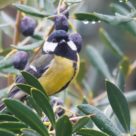Out of the Corsican products which make an appearance on our tables this season, we have gone for the most famous of all…cooked meats!
Together, let’s take a closer look at the range of meats on offer…
First we had u prisuttu; a ham which must dry out for 12 to 18 months to reach optimum quality. Then we were served a salciccia (sausage) and u lonzu, salted and dried loin consumed after 4 to 5 months of maturing. Next, we tried a coppa, salted and dried spare ribs, consumed after 6 to 7 months of ageing.
A panzetta (salted and dried pork belly), u casgiu di porcu (pork brawn) and u sanguitellu (blood sausage) finished off the platter. These meats are not as well known to the general public but are definitely worth trying.
And the star of the show is…?
The award for the meat you absolutely have to try goes to Figatellu (which is pronounced ‘fiadellou’ in Balagne). This liver sausage (which takes its name from the Italian word for liver) is eaten grilled when fresh or raw if dried for long enough. Just saying its name is enough to make your mouth water!
In Balagne,t the locals love nothing more than sharing a cold meat platter served with a speciality made from chestnut flour, a pulenda, during special events in the village square. So, if you hear of or see a poster advertising “a pulenda – figatellu evening”, you know you are going to have a really good time!
Just for the record…
In 2005 Corsican pork became recognised as an official breed “ Porcu Nustrale”. The first step was then made to having specific origin labels for Corsican products.
Then, following regular quality control checks carried out in situ over the space of four years, the Corsican pork industry was finally rewarded for its efforts. In fact, the Prisuttu, Lonzu and Coppa won awards…and obtained a PDO on March 7th 2012. Corsica then became the first French region to benefit from a Protected Designation of Origin for it so-called “dried” meats.
All that’s left for us to do now is to wish you a wonderful tasting session!





